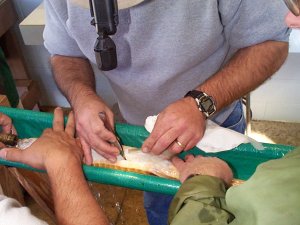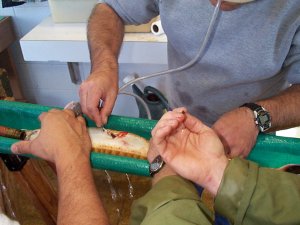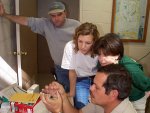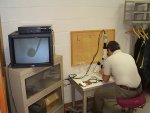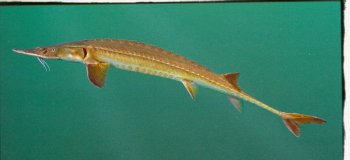
Fate of the Alabama Sturgeon Rests
with the Marion Fish Hatchery
by Thomas H. Wilson, Biologist, Judson
College, Marion, Alabama
March 23, 1999
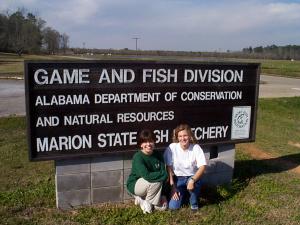 |
Nick Nichols was outside the
Marion Fish Hatchery office leaning against the brick wall and staring up the
highway. He was waiting for a pair of U. S. Fish and Wildlife Service
biologists to arrive and assist him in a surgical procedure on an Alabama
sturgeon which is a species that is very close to extinction. Nick had invited
me and two Judson College biology majors to observe the procedures. We chatted
with Nick while we waited for the team from the Warm Springs Regional Fisheries
Center in Georgia.
|
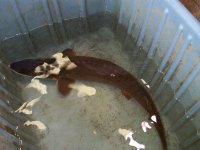
The
Alabama sturgeon, Scaphirhynchus suttkusi Williams & Clemmer, 1991,
has had a rough political existence since being rediscovered in the Alabama
River. A few scientists suggested that the Alabama sturgeon was not a distinct
species and that it actually was a population of Shovelnose sturgeon. DNA
samples have recently proven that the Alabama sturgeon is a legitimate species.
Federal funds and a grant from the Alabama Rivers Alliance have been awarded to
the Marion Hatchery personnel to conduct research on this fish.
The U. S. Fish and Wildlife Service recently issued a proposal to offer
the Alabama sturgeon protection under the Endangered Species Act. Most
environmentalists agree that this sturgeon should be listed as endangered.
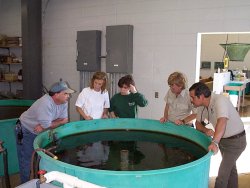
Phil
Kilpatrick is a lead biologist in the Alabama Sturgeon project at Marion. Phil
has spent almost 5,000 line nights attempting to catch these fish with
trotlines baited with earthworms. Phil called Nick and talked about the
sturgeon as we waited for the other members of the team.
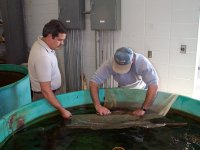
Sasha Hood was writing her senior biology seminar paper on sturgeons and
the opportunity to see the rare Alabama sturgeon and to watch a surgical
procedure to determine the reproductive status of the fish was a tremendous
educational event for all of us. Alison Goolsby shared our interest in the
prehistoric fish, and we listened to Nick explain the project.
“There are only three Alabama sturgeons in captivity in the world
and they are in a tank at the Marion Hatchery. We have one female and two
males. We need to spawn these fish and attempt to raise offspring to be
released into suitable habitats. There are not many of these fish left in the
wild. The continued existence of this species, Scaphirhynchus suttkusi,
Williams & Clemmer, 1991, depends upon spawning in captivity. These ancient
fish live in deep, gravel beds in the river’s current. There is no chance
that they will spawn in ponds,” stated Nichols.
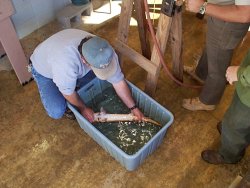
Carlos
Echevarria, Hatchery Manager at Warm Springs, and Haile Macordy, Assistant
Manager, were experienced at the surgical procedure that allows the inspection
and sampling of eggs and testes of the fish. These biologist had recently
worked in Russia with giant, one-ton sturgeons. This was an impressive
cooperative effort between Federal and State Departments of Conservation that
represents the only chance we have of saving the Alabama sturgeon.
“We need to know if the female is ready to spawn. We will have to
open her up and sample some eggs. We have to section these eggs with a blade
and inspect the position of the germinal vesicle in relation to the animal
pole. The closer the germinal vesicle is to the animal pole, the closer the
female is to spawning. We have to boil the egg in order to fix its contents.
Then we can do the sections,” continued Nichols.
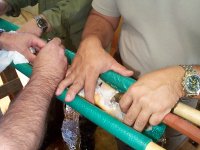
“When we determine the female is ready to spawn, we will inject her
with LHRH, a hormone that stimulates ovulation in fish and also in mammals. We
will then strip the female of eggs by gently rubbing her abdomen and inducing
the release of eggs. Sturgeons are ancient fish, and their eggs are more like
tadpoles than like that of typical bony fishes. The eggs have polarity. There
is an animal pole and a vegetal pole. Also, the ovaries of the sturgeon are not
covered with membranes like other bony fishes,” reported Nichols.
Our lesson in ichthyology was interrupted by the arrival of the men from
Warm Springs. We quickly moved to the area of the tank holding the three
important fish. After a brief but very deliberate planning session, the three
fisheries biologists moved into action.
The largest male sturgeon was removed from the tank and placed
up-side-down in a hammock- like holder. Water was gently run into the mouth of
the fish, and Nick Nichols began the operation. The sharp scalpel made a tiny
slit in the abdomen. Forceps were used to sample the condition of the testes.
“They look good, white and a little folded. I think he is ready,”
remarked Carlos. Nick quickly sutured the incision, applied an antiseptic, gave
the fish an injection of tetracycline, and returned it to the tank.
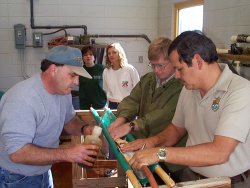 |
The three pound female was lifted from the tank with a net and placed
on the hammock holder. This was a beautiful fish. It was brownish-orange on the
back and light tan on the sides. It had big eyes, long barbels in front of the
mouth, and a white abdomen. “Look at the hairy lips on this sucker. I have
never seen that on a sturgeon before,” commented Carlos.
Nick quickly made a small incision into the abdomen and a few eggs exuded
from the slit. A catheter was used to suck out a few more eggs from the female.
Nick sutured the incision, treated the fish, and returned her to the tank.
|
The eggs were taken to the hatchery laboratory and boiled for a few
minutes to fix the contents before sectioning. An egg was placed on the
dissecting microscope that was equipped with a camera and a monitor. We watched
the monitor as Carlos inspected the egg’s morphology. “This egg is
entirely black. This makes it difficult to tell the poles. It looks ripe. I
think you will be able to spawn the fish by Friday of this week,”
exclaimed Carlos.
|
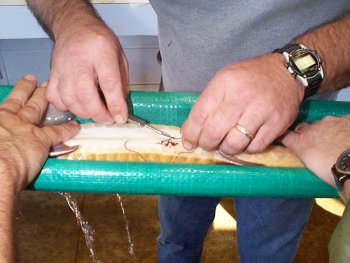 |
We thanked the men for allowing us to be part of such and exciting and
important educational event. We have a special feeling for the Alabama
sturgeon. It used to be common in the Cahaba River and we hope that the work at
the Marion Fish Hatchery will bring this ancient species back to life and,
especially, back to the Cahaba.
Digital Images and Web
Design by Thomas Wilson






